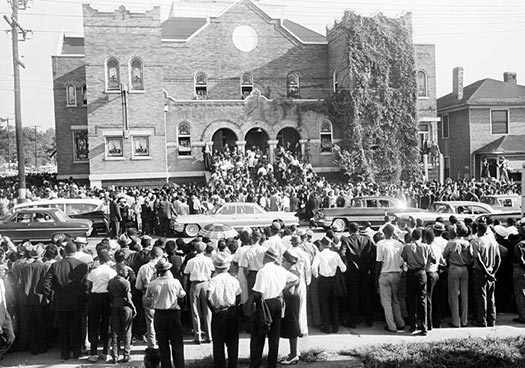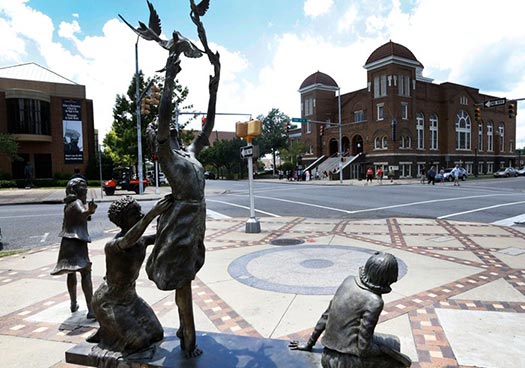Birmingham, AL: 1963
A dynamite bomb detonates under the steps of 16th Street Church, killing four children.
Birmingham, AL: 1963
Detonan una bomba de dinamita bajo la escalera de la Iglesia de 16th Street, lo que causa la muerte de cuatro niñas.




Since its construction in 1911, 16th Street Baptist Church had served as the centerpiece of the city’s African American community, functioning as a meeting place, social center, and lecture hall. Because of its importance to the community, the church served as headquarters for civil rights mass meetings and rallies in the early 1960s.
In an effort to intimidate demonstrators, members of the KKK routinely telephoned the church with bomb threats. Throughout the civil rights movement, Birmingham was a major site of protests, marches, and sit-ins that were often met with police brutality and violence from white citizens. Homemade bombs planted by white supremacists in homes and churches became so commonplace that the city was sometimes known as “Bombingham.”
When a bomb detonated on September 15, 1963, church members were attending Sunday school classes before the start of the 11 a.m. church service. Addie Mae Collins, Cynthia Wesley, and Carole Robertson, all age 14, and Denise McNair, age 11, were killed. Despite repeated demands that the perpetrators be brought to justice, the first trial in the case was not held until 1977, when former Klan member Robert E. Chambliss was convicted of murder. The case was reopened in 1980, 1988, and again in 1997, when two other former Klan members—Thomas Blanton and Bobby Frank Cherry—were brought to trial, eventually receiving life sentences.
Image Descriptions
- The force of 19 pieces of dynamite hidden under the stairs left a large crater at the base of the church and blew out the windows of the building on the other side of the street.
- Bombing victims, from left to right: Denise McNair, Carole Robertson, Addie Mae Collins, and Cynthia Wesley.
- An overflow crowd attends memorial services at Sixth Avenue Baptist Church for three of the four girls killed in the bombing.
- A memorial statue now stands in Kelly Ingram Park, directly across from the church, fully restored.




Desde su construcción en 1911, la Iglesia Bautista de 16th Street ha sido el núcleo de la comunidad afroamericana de la ciudad, funcionando como lugar de reunión, centro social y sala de conferencias. Debido a su importancia para la comunidad, la iglesia funcionó como sede central de las multitudinarias reuniones y congregaciones en favor de los derechos civiles a principios de la década de 1960.
En un esfuerzo por intimidar a los manifestantes, los miembros del KKK telefoneaban con frecuencia a la iglesia para comunicar amenazas de bomba. A lo largo del movimiento por los derechos civiles, Birmingham fue un importante lugar de protestas, marchas y sentadas ante las que la policía y los ciudadanos blancos respondieron con brutalidad y violencia. Se hizo tan común que los supremacistas blancos plantaran bombas caseras en iglesias y hogares que la ciudad se ganó el apodo de “Bombingham”.
Cuando se detonó una bomba el 15 de septiembre de 1963, los feligreses asistían a las clases de la escuela dominical antes del servicio que comenzaba a las 11 a.m. Addie Mae Collins, Cynthia Wesley y Carole Robertson, todas de 14 años de edad, junto a Denise McNair, de 11 años, fueron asesinadas. Pese a las repetidas demandas porque se llevara a los perpetradores ante la justicia, el primer juicio del caso no se llevó a cabo hasta 1977, cuando se condenó al exmiembro del Klan Robert E. Chambliss por homicidio. El caso volvió a abrirse en 1980, 1988 y nuevamente en 1997, cuando otros dos antiguos miembros del Klan —Thomas Blanton y Bobby Frank Cherry— fueron llevados a juicio para ser finalmente sentenciados a cadena perpetua.
Descripciones
- La potencia de las 19 piezas de dinamita colocadas bajo las escaleras dejó un gran cráter en la base de la iglesia e hizo explotar las ventanas del edificio al otro lado de la calle.
- Víctimas del bombardeo, de izquierda a derecha: Denise McNair, Carole Robertson, Addie Mae Collins y Cynthia Wesley.
- Una gran multitud asiste a los funerales realizados en la Iglesia Bautista de la Sixth Avenue para tres de las cuatro niñas asesinadas en la explosión.
- En la actualidad, una estatua conmemorativa se erige en el parque Kelly Ingram, directamente frente a la iglesia, que se ha restaurado por completo.



